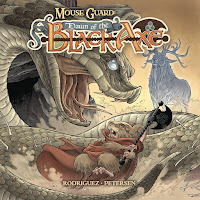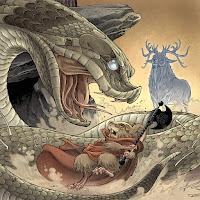This year the piece is titled 'Belladonna'. Below I'll show the step-by-step of creating the art.
This piece started more with the character––the mouse is the Matriarch Siobhan (seen in the Black Axe hardcover extras and she will be explored more in the upcoming Dawn of the Black Axe mini series coming out this year). As a Matriarch she was a healer, but there's something about her I always saw as ominous––hence the pairing with Belladonna; a flowering plant known for being poisonous, but also historically used in small doses medically. I drew Sibhan & some of the plant life on a single piece of copy paper, then drew more of the Belladonna on another sheet with the first drawing on a lightpad. Those were then scanned and assembled and I did a quick color blocking to be sure the overall composition was to my liking.I printed out the above layout composite and taped it to the back of a sheet of Strathmore 300 series bristol. On my Huion A3 Lightpad I can see through the surface of the bristol down to the printout to use as a guide for inking. I used a Copic Multiliner SP 0.7 pen.
Lots of the inking was just about weighting the contour lines and only using texture sparingly (like the density of the veins in the leaves, the spots of the blooms, the shading on the berries, and the embroidery on her stole.
I also added color holds (areas where I want the linework to be a color other than black) to the leaf veins, the spots on the blooms, the berry highlights, and the chalice details.
Some of the color palette was already dictated by the character's look in Dawn of the Black Axe and the belladonna coloring was inspired from several photos found online.
The last step was to render the color with shadows, highlights, and texture. I do most of that work with the Dodge and Burn tools in Photoshop, though I did use a soft paintbrush here and there and several areas where I shifted the color of an area when I had it lassoed (with a feathered edge).The Belladonna print will be signed and numbered, available at ECCC next month and then in my online store afterwards.
























































